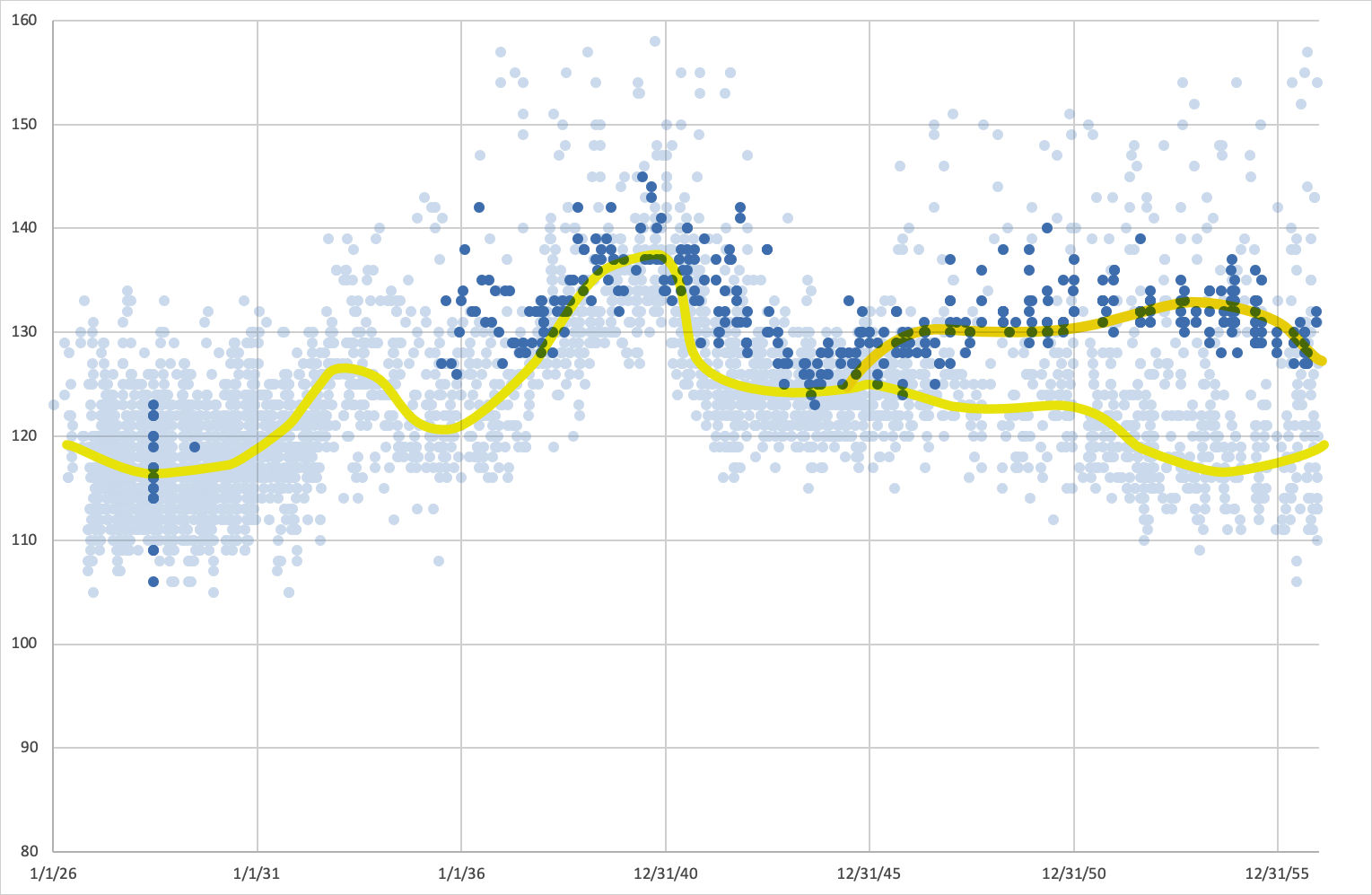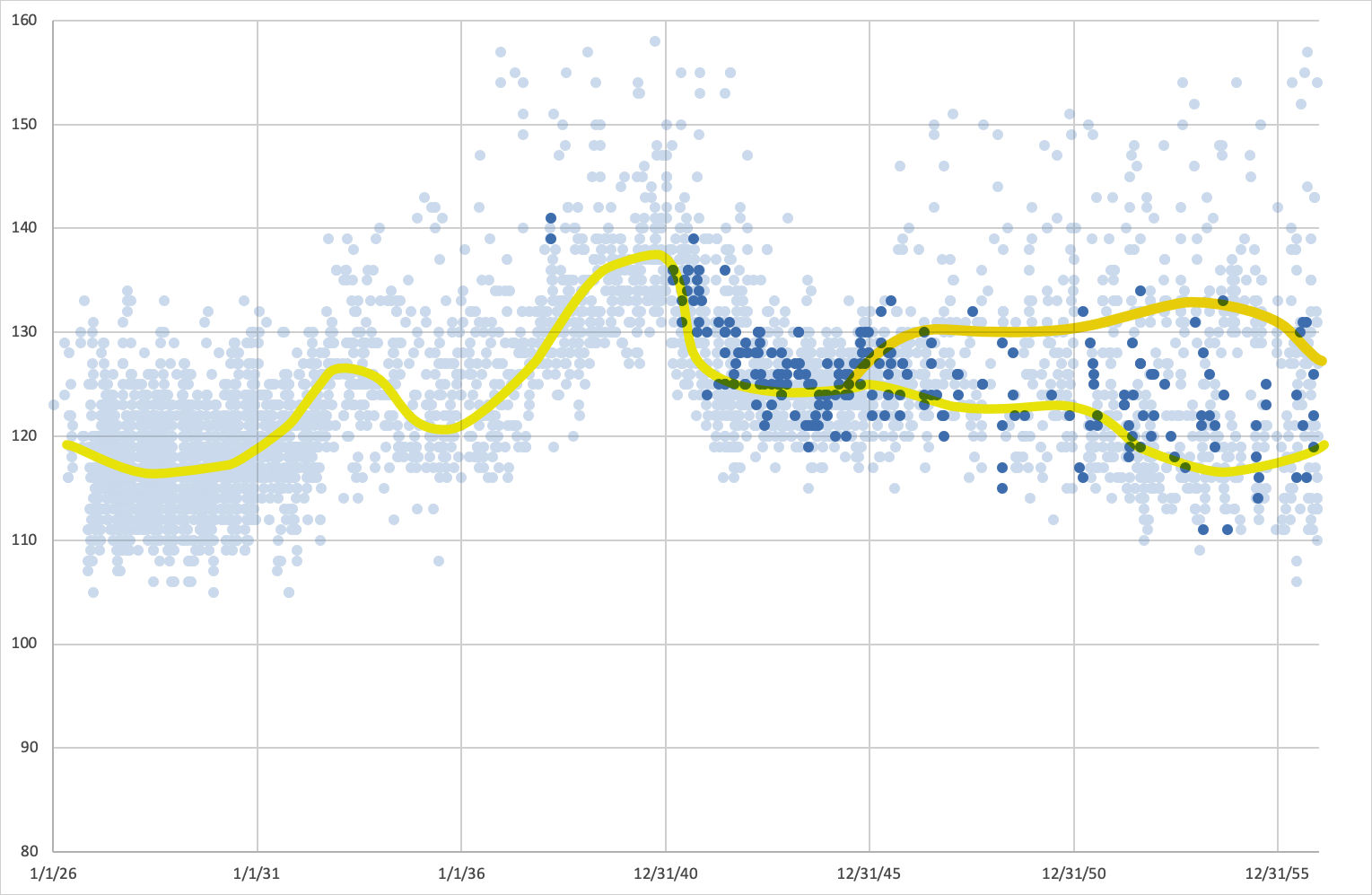The 7 main bands of the Edad d’oro, from around 1936 up to 1956, all started recording their most popular music between 1935 and 1943. The eigth mainstream band in this period is Canaro’s, managing to keep his popularity well into the late fourties. The images here plot the tempo of the tunes in a timeline running from the beginning of 1926 until the end of 1956, ageinst a backdrop of what could be seen as the ‘mainstream’ of Argentine classical tango, the 9 main guardia nueva orchestras represented here as well as the 7 main edad d’or orchestras, D’Arienzo, Di Sarli, Pugliese, Troilo, Caló, D’Agostino, and Tanturi, a data set of 4847 recordings.
It is interesting to see how D’Arienzo’s tempo is in comparison to the general trends. He did his initial recordings in 1928, which pretty much adhere to the main trends. When he returns to recording in late 1935 and 1936 we can see that he is already playing a more rapid tempo than most, with most recordings already in the range from 130–135 bpm, going up to 142 bpm. He slows a bit down in 1937, still being in the top part of the tempo range, before increasing his beat again in 1939, with the bulk of his tunes from 1939–1942 between 132 and140 bpm. After that, as the general beat slows down he follows suit, although he is still always in the upper levels, in 1943 ranging between 124 and 129 bpm. After 1945 his beat increases slowly, by 1946 mostly being between 130 and 135 bpm. In this way he defines the upper curve of the mainstream. D’Arienzo has long been called the king of beat, and according to this he has since 1935 been a leader in playing the faster tangos, always in the fast range of the curve.
Di Sarlis early songs are quite diverse in beat, although he seems to have moved quite fast from around 115 in 129 bpm up to roughly 130 bpm in 1930, before ceasing recording. When he returns to recording in 1939 he starts off with a fast beat, perhaps as a way of introducing himself by following the trends. He then rapidly slows down to the lower end of the spectrum, playing mostly between 118 and 126 bpm from 1942–1948. After he resumes recording in 1951 his beat is at times a bit slower, mostly between 115 and 123 bpm, following the lower trend of the mainstream.
Troilo, has a couple of tunes in fast tempo in 1938. When he starts recording on a moreregular basis in 1940 his beat is between 130 and 137 bpm, dropping to between 124 and 130 bpm in 1942. from then on, until 1948 his tempo follows the mainstream, being mostly between 130 and 130. After that, we can say that he does not follow any particular trendst, playing songs in slow tempo, down to 115 bpm and faster, up to 134 bpm, intermiddedly, following the general trends.
When Pugliese finally started recording, in mid-1943, he is playing in the slower range of the mainstream, mostly between 120 and 125 bpm. Over the years he mostly keeps to that tempo, following the lower trend after 1945 and with a general variation of between 114 and 126 bpm for the most part.
Caló’s recordings are quite sporadic up until 1942. Up til then they are roughly in the range between 120 and 132 bpm, never going above that. After 1942 he keeps a very steady tempo, varying for the most part between 120 and 130 bpm and not affected by the general trends.
D’Agostino only starts recording in late 1940. His original recordings are around 134 bpm, but after that he rarely goes above 130 bpm, his recordings for the most part being in the range 118–128 bpm. After the gap in recording from 1947 until late 1951, his tempo slows down a bit, following the lower trend of the mainstream, being mostly between 115 and 120 bpm.
Tanturi, however, tends to play quite a rapid beat. His recordings at the end of 1940 are fast, at about 140 bpm, but his tempo drops off fast, according to the main trend, being roughly between 124 and 130 bpm until early 1948, when his activity ceases for the most part.






